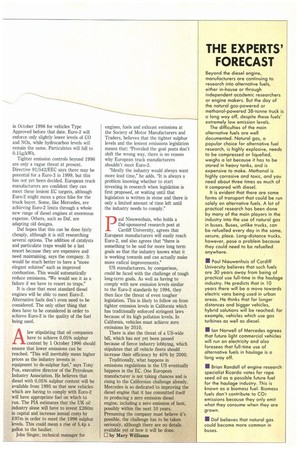LEADER OF THE PACK
Page 40

Page 41

If you've noticed an error in this article please click here to report it so we can fix it.
The EC directive (91/542/EEC), better known as Euro-1, has completed consultation and is shortly to be drawn up in UK law as Road Vehicles (Construction and Use) Regulations 1992. From July this year all Type Approved new trucks will have to comply with Euro-1 emission levels, which will be followed by Euro-2. From October 1993 engines in vehicles Type Approved before July 1992 will have to meet Euro-1.
Unless the lobbying activities of environmentalists force the date to be pushed forward, or the lobbying activities of the motor industry push it back, Euro-2, will come into effect at the end of 1995 for new Type Approved trucks, and in October 1996 for vehicles Type Approved before that date. Euro-2 will enforce only slightly lower levels of CO and NOx, while hydrocarbon levels will remain the same. Particulates will fall to 0.15g/kWh.
Tighter emission controls beyond 1996 are only a vague threat at present. Directive 91/542/EEC says there may be potential for a Euro-3 in 1999, but this has not yet been decided. European truck manufacturers are confident they can meet these lenient EC targets, although Euro-2 might mean a price hike for the truck buyer. Some, like Mercedes, are achieving Euro-2 limits through a whole new range of diesel engines at enormous expense. Others, such as Daf, are adapting old designs.
Daf hopes that this can be done fairly cheaply, although it is still researching several options. The addition of catalysts and particulate traps would be a last resort because they are expensive and need maintaining, says the company. It would be much better to have a more elegant solution" such as improved combustion. This would automatically reduce emisisons. "We would see it as a failure if we have to resort to traps."
It is clear that most standard diesel engines will be able to meet Euro-2. Alternative fuels don't even need to be considered. The only other thing that does have to be considered in order to achieve Euro-2 is the quality of the fuel being used.
Alaw stipulating that oil companies have to achieve 0.05% sulphur content by 1 October 1996 should ensure that lower emissions can be reached. "This will inevitably mean higher prices as the industry invests in equipment to de-sulphur fuel," says Tony Fox, executive director of the Petroleum Industry Association. He believes that diesel with 0.05% sulphur content will be available from 1995 so that new vehicles which are having to comply with Euro-2 will have appropriate fuel on which to run. The PIA estimates that the UK oil industry alone will have to invest £260m in capital and increase annual costs by £97m in order to meet the 1996 sulphur levels. This could mean a rise of 5.4p a gallon to the haulier.
John Singer, technical manager for engines, fuels and exhaust emissions at the Society of Motor Manufacturers and Traders, believes that the tighter sulphur levels and the lenient emissions legislation means that: "Provided the goal posts don't shift the wrong way, there is no reason why European truck manufacturers shouldn't meet Euro-2.
"Ideally the industry would always want more lead time," he adds. "It is always a problem knowing whether to start investing in research when legislation is first proposed, or waiting until that legislation is written in stone and there is only a limited amount of time left until the industry needs to comply."
Pau] Nieuwenhuis, who holds a Daf-sponsored research post at Cardiff University, agrees that European manufacturers will easily reach Euro-2, and also agrees that "there is something to be said for more long term goals so that the industry knows what it is working towards and can actually make more radical improvements."
US manufacturers, by comparison, could be faced with the challenge of tough long-term goals. As well as having to comply with new emission levels similar to the Euro-2 standards by 1994, they then face the threat of even tougher legislation. This is likely to follow on from tighter emission levels in California which has traditionally enforced stringent laws because of its high pollution levels. In California, vehicles must achieve zero emissions by 2010.
There is also the threat of a US-wide bill, which has not yet been passed because of fierce industry lobbying, which stipulates that all vehicle fleets should increase their efficiency by 40% by 2000.
Traditionally, what happens in emissions regulations in the US eventually happens in the EC. One European manufacturer is not taking chances and is rising to the Californian challenge already. Mercedes is so dedicated to improving the diesel engine that it has committed itself to producing a zero emission diesel engine, including a zero emission of heat, possibly within the next 10 years. Presuming the company must believe it's possible, the challenge has to be taken seriously, although there are no details available yet of how it will be done. 0 by Mary Williams




















































































